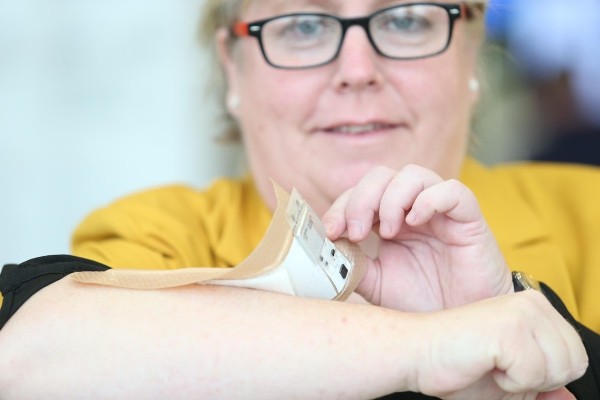
Smart woundcare is widely recognised as one of the key emerging MedTech applications.
But, what is Smart woundcare? Smart woundcare is the merger of highly miniaturized electronic and communications technologies with conventional wound dressing materials, with the resultant outcome being the development of wireless smart wound dressings that provide healing updates wirelessly to smartphones, PCs, tablets etc.
Smart woundcare approaches are expected to revolutionise wound treatment on a global scale, leading to enhanced personal, social and healthcare system outcomes.
In contemporary woundcare, disturbing a dressing can regress the wound healing by up to 12 hours. This is not ideal as non-healing wounds require care for an indeterminate length of time and place high demands on hospital and clinic resources. Contrary to this, smart woundcare technologies enable remote care, through continuous wound monitoring and provision of pre-emptive alerts to adverse changes in wound healing. By addressing these grand challenges Smart wound technology has the potential to disrupt chronic woundcare by improving healing outcomes and reducing demands on hospital beds and clinic services.
Chronic wounds are painful, curtail social and economic activities, are taxing on patients and their families, and are life- and limb-threatening. For example, a diabetic foot is amputated every twenty seconds.
Sadly, the prevalence of chronic wounds is increasing, due in part to the rising average age of the population, along with a growth in the prevalence of obesity, diabetes and lower extremity disease. The economic cost of prolonged woundcare is significant, with the annual care of a single chronic ulcer costing approximately €10,000, with the global cost expected to top €13.5B by 2025.
Unsurprisingly, woundcare in itself is a challenging environment; dressings must be comfortable to wear, easy to use, highly flexible, and safely disposable. Successful adoption of smart wound dressings will therefore depend on the development of medical-grade technology platforms for flexible and biodegradable electronics, body-worn communications, and advanced packaging.

Smart dressings will be capable of monitoring and managing the condition of chronic wounds in the home, and will notify the patient’s smartphone when, for example, the dressing needs changing or if the wound becomes infected. They are expected to have an enormous impact in the early diagnosis, efficient management and advanced treatment of conditions such as diabetic foot ulcers, venous leg ulcers and pressure ulcers.
Today, there are no pure smart dressings on the market. To address this global need, Tyndall is working with several Irish and European partners, both academic and industrial. Led by Dr Conor O’Mahony, the Micro Transdermal Interface Platforms (MicroTIPs) team has already developed prototype dressings and patented design concepts.
Key to this activity is PhD researcher Suzanne O’Callaghan. Ms O’Callaghan has recently completed and published an intensive review of the current state of the art in smart dressing development. The review highlighted the challenges involved with diagnosing and treating hard-to-heal wounds, including the subjective nature of diagnostic procedures, the difficulty of adequately monitoring wound healing in the patient’s own home, and the over-frequent changing of dressings resulting from a lack of information regarding the condition of the wound. She also placed a particular emphasis on new sensor technologies for monitoring wound parameters such as pH, dressing saturation, infection levels, healing progress and exudation rate.
Although Ms O’Callaghan concluded that significant progress has been made in advancing the development of smart wound dressings, she also identified the need for further developments in areas such as eco-friendly battery technology, flexible electronics, and artificial intelligence. Tyndall will now work to provide deep-tech solutions to these challenges in order to maximise the potential benefits offered by smart woundcare.
Professor Zena Moore, Director of the Skin Wounds & Trauma (SWaT) Research Centre at the RCSI University of Medicine and Health Sciences was a co-author on the paper. Prof Moore and her colleagues at the SWaT Research Centre also recognise the need to extend modern day woundcare into the development, testing and full scale use of Smart woundcare methods and systems of care. Prof Moore has said that,
Better woundcare outcomes for those most in need are stymied by a lack of cutting edge technological development that could significantly improve the way non healing wounds are treated. The SWaT Centre work with Tyndall and Suzanne involves new ways of thinking about woundcare that will lead to the creation of new technological devices and systems of care which will lead to better outcomes for patients, families and health care systems generally. The paper led by Suzanne, which is part of her PhD thesis, forms part of what is a highly significant approach to disrupting current methods of wound care for the better.
Read more on the research paper here.
Ms O’Callaghan was lead author of this literature review which will form part of her PhD thesis. As the research is a collaboration between Tyndall and woundcare specialists at the Royal College of Surgeons in Ireland (RCSI), the paper also strengthens Tyndall’s links with the RCSI’s Skin Wounds and Trauma (SWaT) Network, and will help in steering future research and development in this area. The work has received funding from the ECSEL JU (Electronic Component Systems for European Leadership Joint Undertaking) under grant agreement No 662155, from Enterprise Ireland under the International Research Fund IR/2015/0032, and from Science Foundation Ireland through the Insight Centre.
Updated: 1 September 2020
